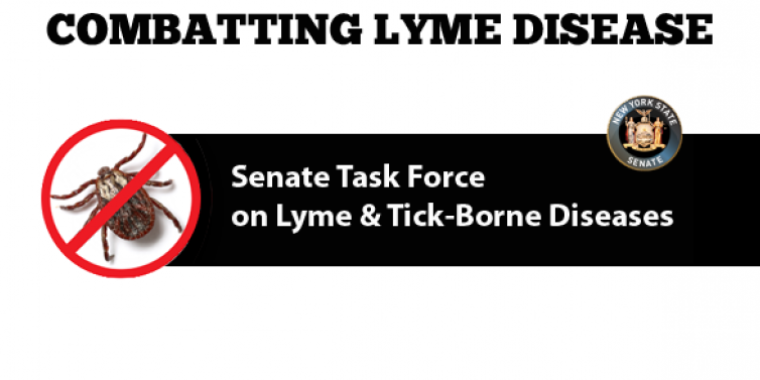
O’Mara continues as a member of Senate Task Force on Lyme Disease: Key task force recommendations signed into law last year
February 7, 2017
-
ISSUE:
- Lyme Disease

Elmira, N.Y., February 7—As regional concerns about Lyme and other tick-borne diseases have dramatically increased over the past few years, State Senator Tom O’Mara (R,C,I-Big Flats) said today that he will continue to serve as a member of the State Senate Task Force on Lyme and Tick-Borne Diseases in 2017.
“It’s a debilitating disease that’s a major concern for everyone who enjoys the outdoors. It’s a serious public health threat that continues to demand our attention, and action,” said O’Mara, chairman of the Senate Environmental Conservation Committee. “We’re continuing to work to encourage and implement state- and federal-level action plans and a comprehensive response. Those who suffer from Lyme disease can endure years of frustration seeking effective diagnosis and treatment. We want to raise awareness and education, as well as enhance prevention and treatment strategies.”
The 17-member task force released a report in 2015 proposing a comprehensive set of legislative recommendations to enhance research, prevention, diagnosis and treatment for these harmful illnesses – including one key initiative unanimously approved by both houses of the Legislature and signed into law by Governor Andrew Cuomo in 2015. That new law (S.7854, Chapter 532 of the Laws of 2015) helps people who may benefit from innovative and effective alternative medical treatment. It prevents the state from charging medical professionals with misconduct when the sole issue is providing or recommending treatment for Lyme and other illnesses not universally accepted by the medical community.
Last year, O’Mara co-sponsored two new Lyme-related laws proposed by the task force:
> Senate Bill Number 5803 (Chapter 167 of the Laws of 2016) requires the state Department of Health (DOH) to design, develop and disseminate an aggressive, comprehensive and statewide public awareness, education and prevention campaign to reduce the public’s exposure to Lyme and other tick-borne infectious diseases. It recognizes the effectiveness and importance of early education and prevention in preventing the spread of these diseases; and
> Senate Bill Number 5804 (Chapter 109 of the Laws of 2016) complements the statewide DOH awareness campaign by requiring the development of age-appropriate instructional materials and tools that will be made available to schools and libraries to help reach school-age children with the awareness and prevention message. Supporters of the legislation cite an increasing demand from school and libraries for instructional materials geared towards children.
Last October, O’Mara sponsored a “Public Awareness Forum on Lyme and Tick-Borne Diseases” at the Big Flats Community Center. A panel of regional public health professionals, educators and researchers led a discussion on raising awareness, and ongoing prevention efforts and strategies. The panel included representatives from the Chemung County Health Department, Cornell Cooperative Extension and Cornell University.
The Senate task force was created in 2013. Senator Sue Serino of the Hudson Valley, a region where the problem has been particularly acute for years, currently chairs it. O’Mara said that the task force intends to continue holding public forums and working on additional legislative recommendations to enhance the detection, prevention and treatment of tick-borne illnesses in New York.
Approximately 300,000 Americans are diagnosed with Lyme disease annually, according to the federal Centers for Disease Control and Prevention. More than 450 new cases of Lyme disease were reported in New York State alone last year. That number is expected to continue rising as disease-laden ticks spread to more and more regions of the state, including the Southern Tier and Finger Lakes.
Share this Article or Press Release
Newsroom
Go to Newsroom


